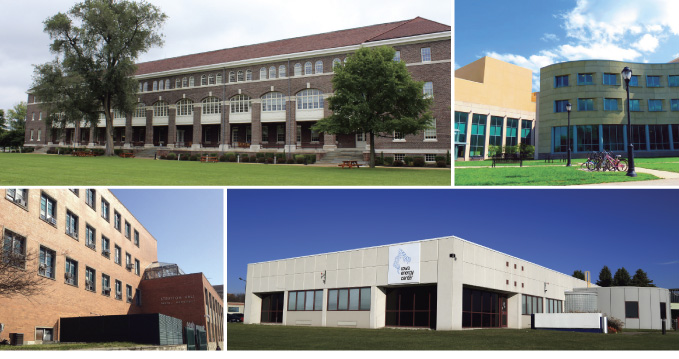Market Challenge
Owners and operators of existing commercial buildings are typically capital constrained, risk averse, and have little experience with energy management. They want cost-effective proven solutions when considering an energy upgrade. In many cases, simple upgrades such as lighting replacements have been completed. Other systems such as HVAC systems and the building envelope (windows, walls, doors) have a long product life or require invasive and disruptive action. The ability of service providers or utilities to offer packaged solutions with a reasonable payback period, reliable long-term savings estimates, and an implementation plan would help building owners decide to implement new energy efficient solutions.
Improved operations in existing buildings through advanced monitoring, controls, and automated diagnostics has the potential to significantly reduce energy use and operational costs with limited investment in hardware. However, this generally requires significant labor costs to engineer and implement site-specific approaches, and the overall economics have not been favorable for many commercial buildings. In order to penetrate this underserved market, automated software solutions are needed that require minimum configuration and can adapt over time to changing equipment performance. Proven packages of technologies and no-touch sensors and controls can be simple and inexpensive solutions for this market, even though developing them can be complicated.
Approach
Given the scope and scale of small/medium buildings and the diversity of existing technologies and operational challenges, CBEI started by developing a market characterization and technology roadmap to prioritize opportunities. As a result of these efforts, CBEI determined that the greatest opportunities existed for packages of HVAC technologies, envelope (windows, walls, doors) retrofits, and building operations solutions utilizing sensors and controls.
For the HVAC packages and envelope retrofits, CBEI identified solutions by specific building type and climate zone. To do this, numerous configurations were considered and evaluated using computational modeling as well as input from industry experts. Once solutions were developed, tools and best practice guides were developed to accelerate adoption.
For building operations, CBEI identified the need to increase automation, while minimizing the need for new equipment. Adding automation also generally requires site-specific training of the solution, and CBEI has worked to develop computational approaches that reduce the time and training needed for tailoring the solution to the building. CBEI has focused on developing virtual sensors to reduce the need for physical sensors, controls-oriented models that can be automatically trained using low cost measurements, and embedded approaches for automated fault detection and diagnostics (AFDD). To accomplish this, CBEI also needed to develop virtual testbeds, laboratory test setups, and field demonstration sites to assess solution performance.
 The envelope has a substantial impact on building energy use, but envelope retrofits are rarely undertaken due to higher upfront costs and lengthier payback compared to lighting or HVAC retrofits. CBEI has focused on both roof and wall retrofits. For roof retrofits, CBEI evaluated the impact of increased insulation, reflective membranes, and sky lighting. Modeling confirmed that insulation between R20 – R30 can save 26% on heating loads in low rise buildings. Additionally, a reflective roof can reduce cooling loads by 12%, and incorporating skylights with lighting controls can save 19% on lighting loads when both are integrated with effective insulation. Furthermore, dynamic skylights were shown to keep room temperatures more consistant providing a better occupant experience.
The envelope has a substantial impact on building energy use, but envelope retrofits are rarely undertaken due to higher upfront costs and lengthier payback compared to lighting or HVAC retrofits. CBEI has focused on both roof and wall retrofits. For roof retrofits, CBEI evaluated the impact of increased insulation, reflective membranes, and sky lighting. Modeling confirmed that insulation between R20 – R30 can save 26% on heating loads in low rise buildings. Additionally, a reflective roof can reduce cooling loads by 12%, and incorporating skylights with lighting controls can save 19% on lighting loads when both are integrated with effective insulation. Furthermore, dynamic skylights were shown to keep room temperatures more consistant providing a better occupant experience.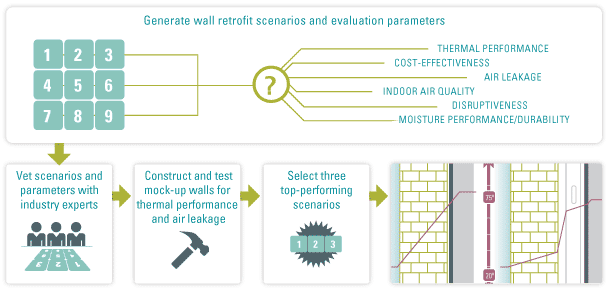
 HVAC accounts for, on average, 30% of energy use in small/medium buildings. There are multiple pathways to reduce HVAC energy use that range from the very simple (e.g., duct cleaning) to the very sophisticated (e.g., variable refrigerant flow system); however, it is extremely challenging for retrofit providers to consider all the possibilities.
HVAC accounts for, on average, 30% of energy use in small/medium buildings. There are multiple pathways to reduce HVAC energy use that range from the very simple (e.g., duct cleaning) to the very sophisticated (e.g., variable refrigerant flow system); however, it is extremely challenging for retrofit providers to consider all the possibilities.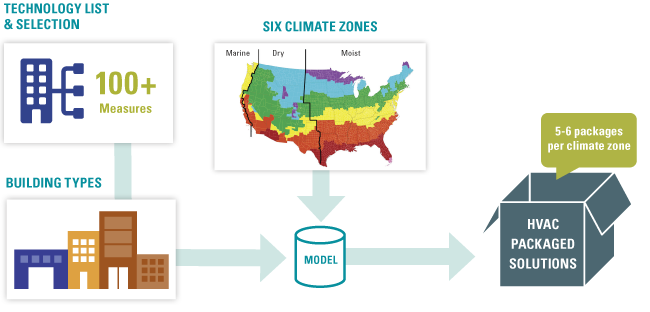

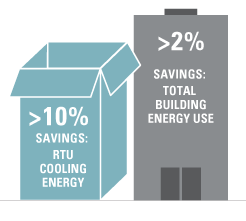 Advanced performance monitoring, control and diagnostic algorithms inevitably require additional sensors, which can be an obstacle to their widespread deployment. A major early focus of CBEI was to develop virtual sensors for indirectly inferring expensive but required measurements from models and physical sensors. CBEI developed and/or demonstrated multiple virtual sensors, including for refrigerant charge, refrigerant mass flow rate, air mass flow rates, compressor power, and cooling capacity.
Advanced performance monitoring, control and diagnostic algorithms inevitably require additional sensors, which can be an obstacle to their widespread deployment. A major early focus of CBEI was to develop virtual sensors for indirectly inferring expensive but required measurements from models and physical sensors. CBEI developed and/or demonstrated multiple virtual sensors, including for refrigerant charge, refrigerant mass flow rate, air mass flow rates, compressor power, and cooling capacity.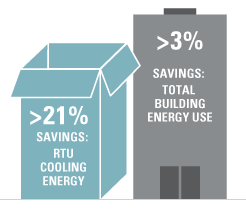 CBEI developed site-specific, control-oriented models that are needed for practical application of model-predictive controls. The models can be trained using data collected over a relatively short time period (e.g., one to two weeks) with better than 10% prediction accuracy. In addition, different approaches for implementation of optimal controls were developed and demonstrated, including distributed approaches for optimal control of multiple zones and air handling units (AHU), a tool-chain for automatically generating model-predictive control solutions for typical commercial buildings, an automated approach for optimal coordination of multiple RTUs that serve open spaces (e.g., large retail stores), optimal control of chiller plants, and integrated optimal control of retail spaces with air conditioning and refrigeration.
CBEI developed site-specific, control-oriented models that are needed for practical application of model-predictive controls. The models can be trained using data collected over a relatively short time period (e.g., one to two weeks) with better than 10% prediction accuracy. In addition, different approaches for implementation of optimal controls were developed and demonstrated, including distributed approaches for optimal control of multiple zones and air handling units (AHU), a tool-chain for automatically generating model-predictive control solutions for typical commercial buildings, an automated approach for optimal coordination of multiple RTUs that serve open spaces (e.g., large retail stores), optimal control of chiller plants, and integrated optimal control of retail spaces with air conditioning and refrigeration.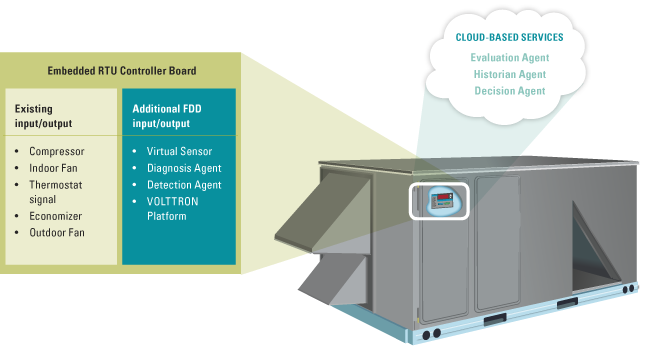
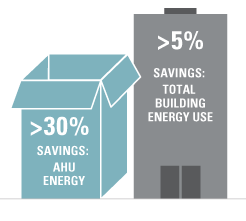 To ensure ongoing high performance in buildings, CBEI developed AFDD approaches for RTUs, built-up AHU, sensors, and whole building diagnostics. The RTU diagnostic methods were specifically developed for factory integration and are based on the use a variety of virtual sensors. Besides being lower cost, virtual sensors facilitate the handling of multiple simultaneous faults. Demonstrations were carried out using laboratory and field testbeds, and the methods were shown to correctly detect and diagnose faults before there was a 10% impact on capacity and efficiency.
To ensure ongoing high performance in buildings, CBEI developed AFDD approaches for RTUs, built-up AHU, sensors, and whole building diagnostics. The RTU diagnostic methods were specifically developed for factory integration and are based on the use a variety of virtual sensors. Besides being lower cost, virtual sensors facilitate the handling of multiple simultaneous faults. Demonstrations were carried out using laboratory and field testbeds, and the methods were shown to correctly detect and diagnose faults before there was a 10% impact on capacity and efficiency.